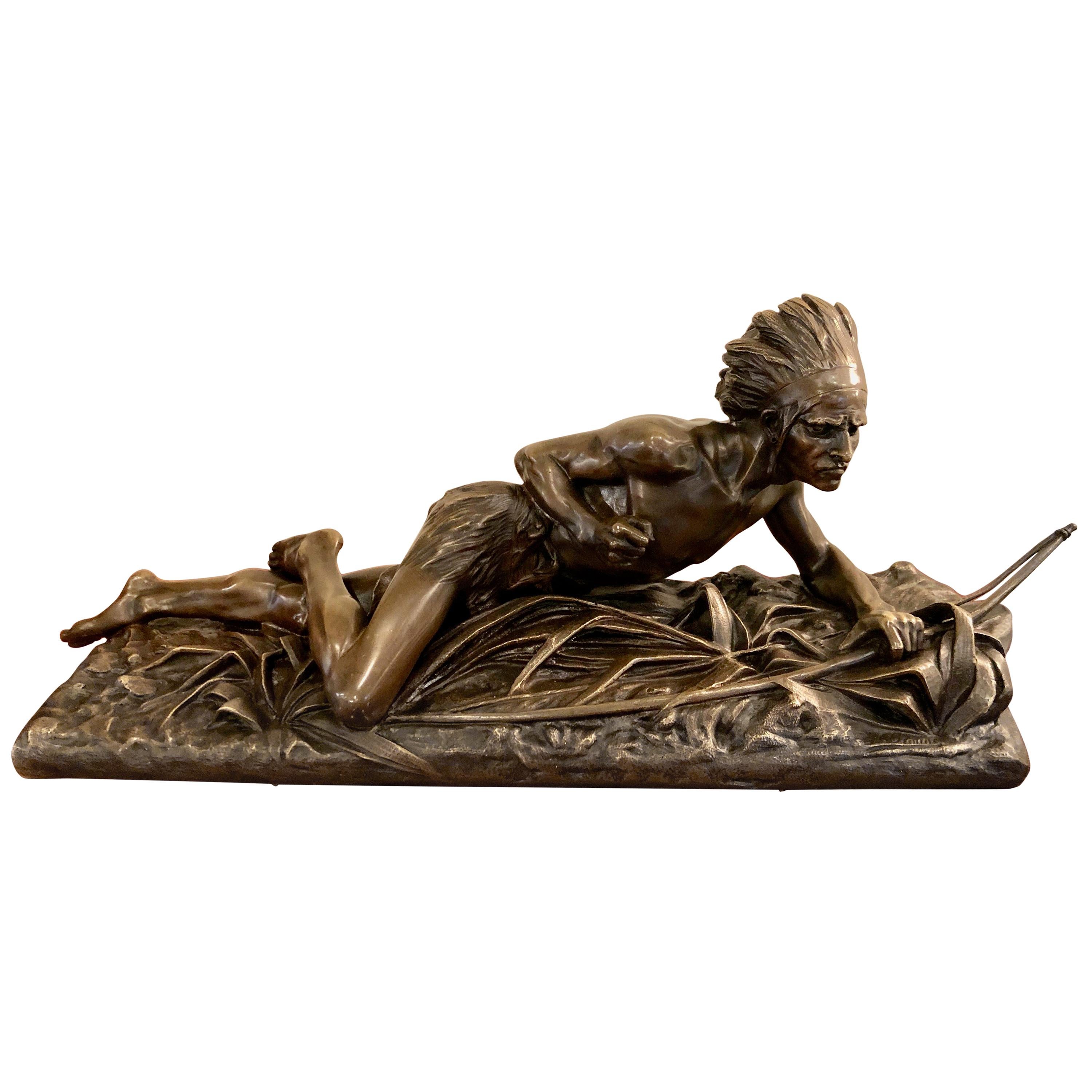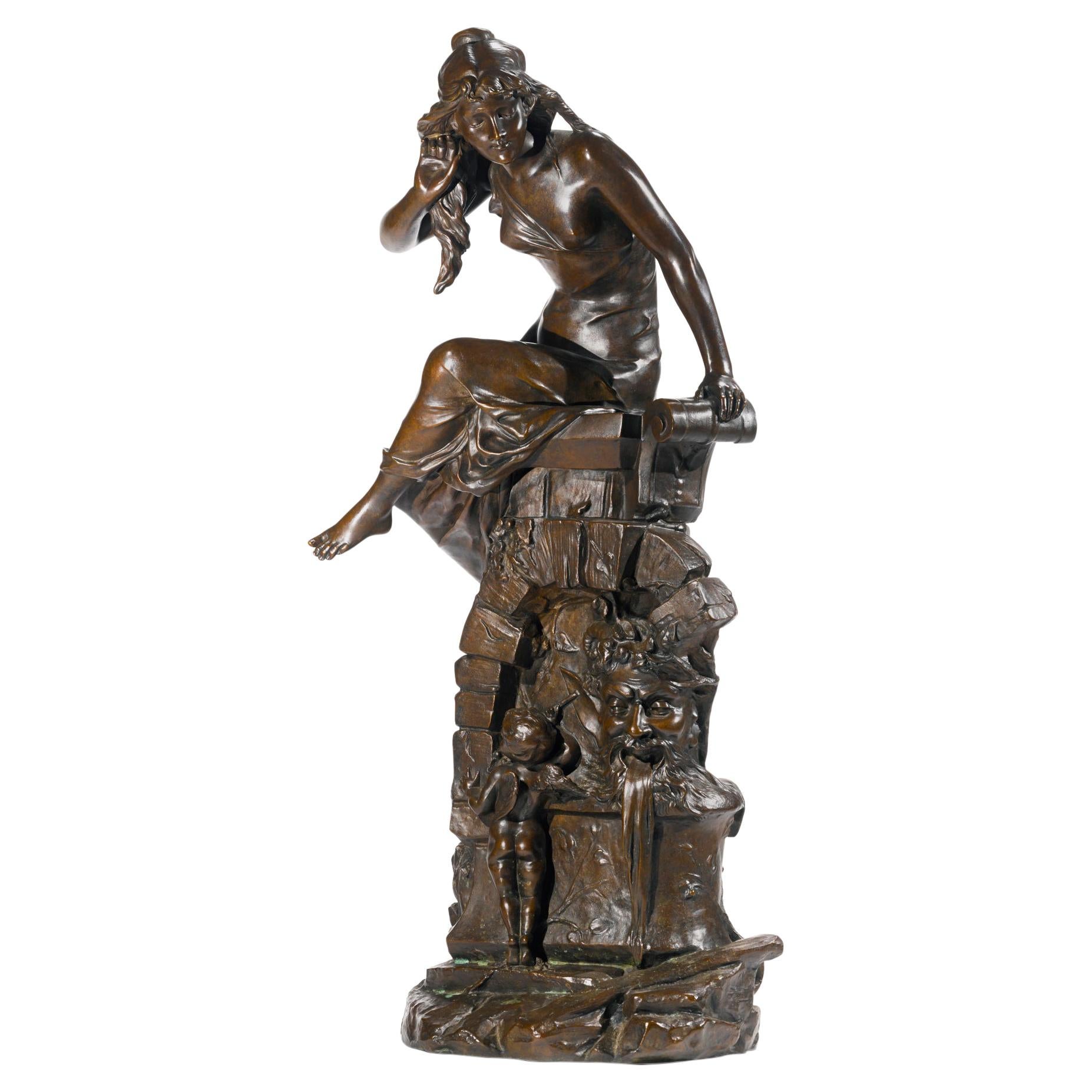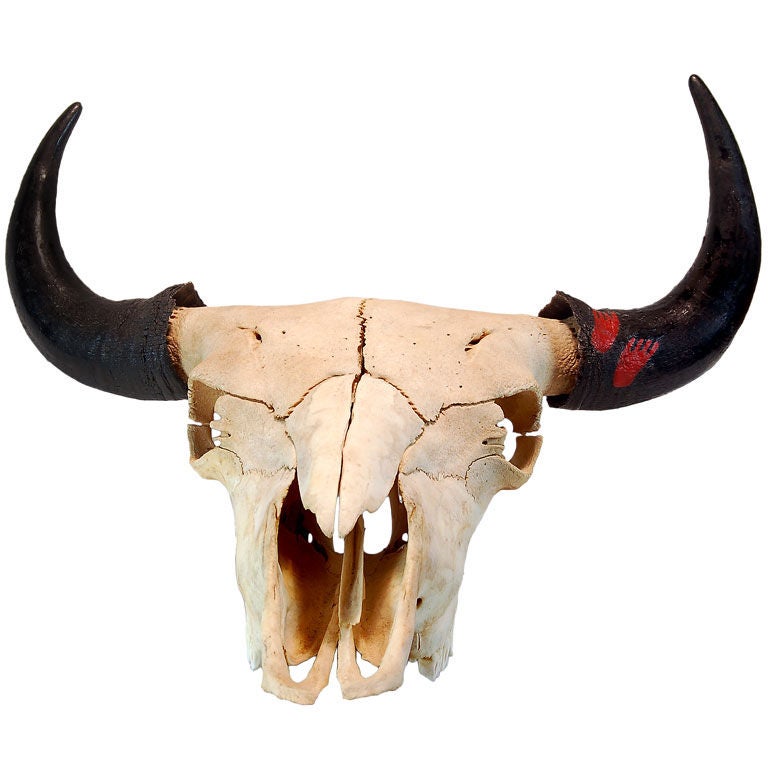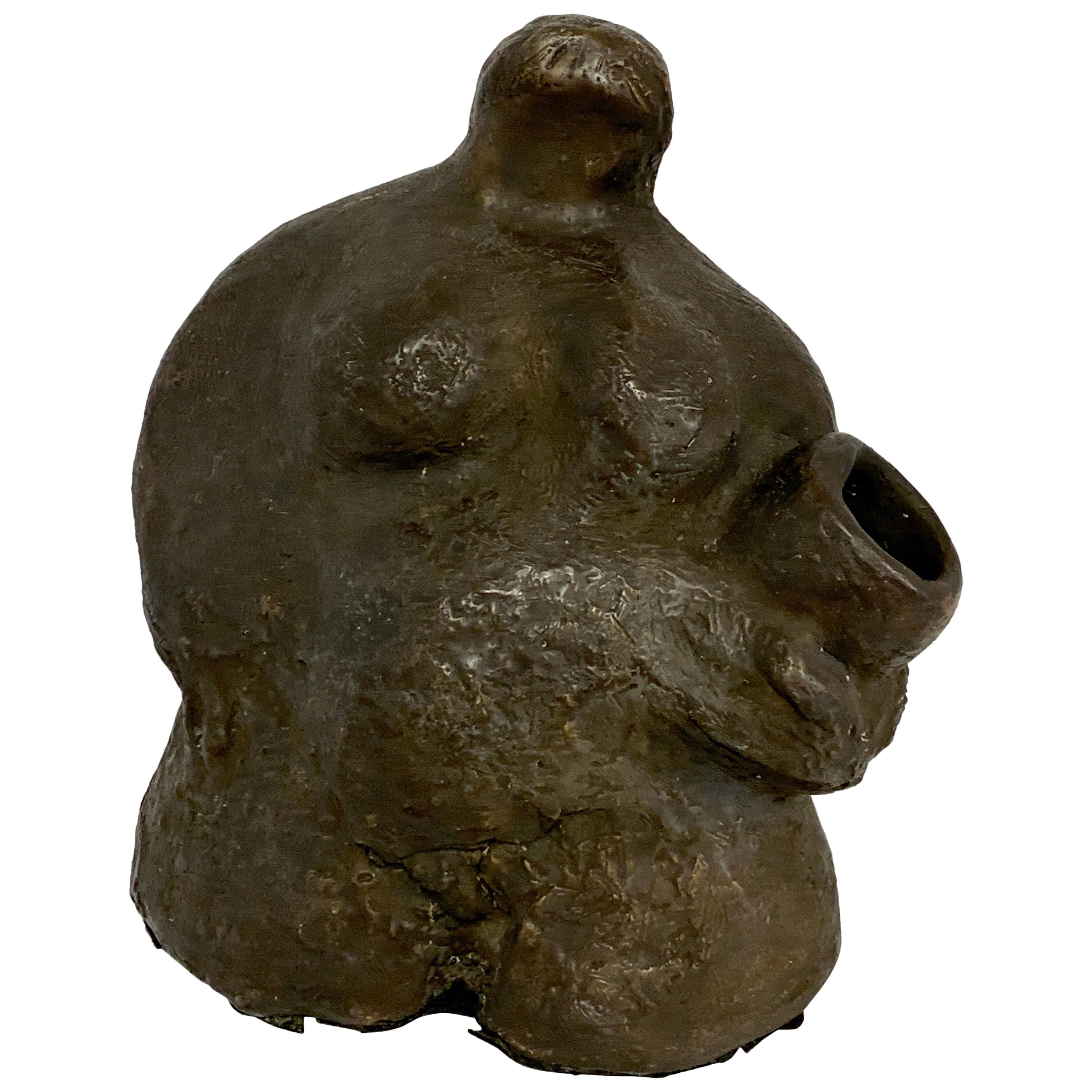Items Similar to French Bronze Sculpture "Crouching Native American Indian" E. Drouot
Want more images or videos?
Request additional images or videos from the seller
1 of 11
French Bronze Sculpture "Crouching Native American Indian" E. Drouot
About the Item
A very fine French, 19th century Patinated bronze group of a Crouching Native American Indian on the lookout, in a dark brown patina and raised on a veined green marble base, by Edouard Drouot (French, 1859-1945). Signed: E. Drouot. The back with the retailer/importer's insert coin/seal "Casa Druillet - 503 Calle 25 de Mayo 503 - Montevideo". circa 1890-1900.
Edouard Drouot (French, 1859-1945). Drouot was not only a prolific sculptor, but a painter as well. He studied in Paris under Mathurin Moreau (1822-1912) and Emile Thomas (1817-1882). He exhibited at the Salon in 1889 and received honourable mention at the 1900 Universal Exposition in Paris. His bronze sculptures were exported to collectors and art dealers alike all-over the world.
Measures: Overall height: 18 inches (45.7 cm)
Overall width: 37 inches (94 cm)
Overall depth: 11 1/2 inches (29.2 cm).
- Creator:Edouard Drouot (Sculptor)
- Dimensions:Height: 18 in (45.72 cm)Width: 37 in (93.98 cm)Depth: 11.5 in (29.21 cm)
- Style:Native American (In the Style Of)
- Materials and Techniques:
- Place of Origin:
- Period:
- Date of Manufacture:circa 1890-1900
- Condition:Wear consistent with age and use. Minor losses. A really beautiful bronze sculpture in great condition with a great patina with some rubbing consistent with age and use. The marble base has some very minor chippings at the edge base.
- Seller Location:Los Angeles, CA
- Reference Number:
About the Seller
5.0
Vetted Seller
These experienced sellers undergo a comprehensive evaluation by our team of in-house experts.
Established in 1982
1stDibs seller since 2016
114 sales on 1stDibs
Typical response time: <1 hour
- ShippingRetrieving quote...Ships From: Los Angeles, CA
- Return PolicyThis item cannot be returned.
More From This SellerView All
- Shona Stone Sculpture "Sheltering Soul" Norbert Shamuyarira (Zimbabwe, b. 1962)Located in Los Angeles, CAAn African Shona Stone Sculpture titled "Sheltering Soul" by Norbert Shamuyarira (Zimbabwean, Born 1962), depicting an abstract polished Shona stone figure of a crouched and bowing h...Category
Late 20th Century Zimbabwean Tribal Tribal Art
MaterialsStone
- After Gaston Leroux French 19th Century Bronze Sculpture of RebeccaBy Gaston Veuvenot LerouxLocated in Los Angeles, CAA fine French 19th-20th century orientalist silvered and gilt patinated bronze sculpture of "Rebecca" with a plaque that reads "Jeune Fille Arabe" (A Young Arab Girl - Water-Carrier)...Category
Antique Early 1900s French Greco Roman Figurative Sculptures
MaterialsBronze
- A French 19th Century Bronze Sculpture Titled "La Sécurité" Eugène DelaplancheBy Eugène DelaplancheLocated in Los Angeles, CAA very fine French 19th century brown and parcel-gilt patinated bronze sculpture titled "La Sécurité" (The Security - Protection) after a model by Eugène Delaplanche (French, 1836–1891). Depicting a sitting young Maiden in a gilt-decorated armored suit and helmet, a lion skin on her back, holding a resting child on her arm. Raised on Rouge-Royal marble plinth inscribed "La Sécurité - Par E. Delaplanche - Salon des Beaux-Arts de Paris". Signed: E. Delaplanche and stamped with the importer's seal - Alberto Vignes y Ca - Buenos Aires, circa 1890. Measures: Height: 28 3/4 inches (60.3 cm). Width: 16 inches (40.7 cm). Depth: 14 inches (35.6 cm). Eugène Delaplanche (February 28, 1836 – January 10, 1891) was a French sculptor, born at Belleville (Seine). He was a pupil of Duret, gained the Prix de Rome in 1864 (spending 1864-67 at the Villa Medici in Rome) and the medal of honor in 1878. His "Messenger of Love" (1874), "Aurora" (1878), and the "Virgin of the Lillies" (1884), are in the Luxembourg. Other works by him are "Music - La Musique" (1878, Paris Opera House), called his masterpiece; "Eve After the Fall" (1869); "Maternal Instruction" (1875, Square of Sainte-Clothilde, Paris). He is also noted for his decorations in relief on vases of Haviland faience. His best work is naturalistic, but at the same time dignified and simple in line and shows sound mastery of technique. He is represented by 15 works in the Glyptothek, Copenhagen and in many other French museums and in churches. This sculpture of La Sécurité is after his 1884 sculptures...Category
Antique Late 19th Century French Belle Époque Figurative Sculptures
MaterialsMarble, Bronze
- Pair French 19th/20th Century Gilt-Bronze Sculptures of The Marly Horses LampsBy Guillaume CoustouLocated in Los Angeles, CAA Fine Pair of French 19th/20th Century Gilt-Bronze Sculptures of "The Marly Horses" (Now turned into lamps) After the original by Guillaume Coustou (French, 1677-1746). The large pair of equestrian bronze sculptures, finished in a gold patina, each depicting rearing horses with their groom, both raised on oval a black slate and Bardiglio marble bases and fitted with modern electrical twin-light brass fittings and cream colored shades. The base on an ebonized wooden platform. Circa: Paris, 1900-1920. Sculpture & Base Height: 31 1/4 inches (79.8 cm) Base Width: 21 3/4 inches (55.3 cm) Base Depth: 12 3/4 inches (32.4 cm) Height to top of (Adjustable) shade fitting: 48 1/4 inches (122.6 cm) Shade Height: 15 inches (38.1 cm) Shade Width: 26 inches (66.1 cm) Shade Depth: 20 inches (50.8 cm) The original Marly Horses are two 1743–1745 Carrara marble sculpted groups by Guillaume Coustou. They were commissioned by Louis XV of France for the trough at the entrance to the grounds of his château de Marly. Coustou's last works, they were intended to replace two other sculpted groups, Mercury on Pegasus and Pegasus, Renown of Horses, both by Antoine Coysevox, which had been removed to the Tuileries Gardens in 1719. Louis XV chose the modellos in 1743 and the full-size sculptures were completed in only two years, being installed at Marly in 1745. They proved highly successful in reproduction, particularly on a smaller scale, and prefigured Théodore Géricault and other Romantic artists' obsession with equestrian subjects. The Marly horses were later also used as the central motif of the monochrome 819-line RTF/ORTF test card which was used on TF1 from 1953 until 1983. The originals were moved to the place de la Concorde in Paris in 1794 and Louis-Denis Caillouette (1790–1868) restored them in 1840. In 1984 it was concluded that the annual military parades on 14 July were damaging the sculptures and they were replaced by marble copies produced by Michel Bourbon in the studio of a subsidiary of Bouygues. The latter also gained the right to an extra copy, which was placed in Bouygues's social building. The original sculptures were moved to a former courtyard in the Richelieu wing of the Louvre Museum, which was renamed the 'cour Marly' in their honour, whilst Bourbon's two main copies were moved to the originals' first site near the trough at Marly, with work overseen by the architect Serge Macel. Guillaume Coustou the Elder (29 November 1677, Lyon – 22 February 1746, Paris) was a French sculptor of the Baroque and Louis XIV style. He was a royal sculptor for Louis XIV and Louis XV and became Director of the Royal Academy of Painting and Sculpture in 1735. He is best known for his monumental statues of horses made for the Chateau of Marly, whose replicas now stand in the Place de la Concorde in Paris. Coustou was a member of a family of famous sculptors; his uncle, Antoine Coysevox, was a royal sculptor; his elder brother, Nicolas Coustou was a sculptor, and his son Guillaume Coustou the Younger also become a noted royal sculptor. Like his older brother, he won the (Prix de Rome) of the Royal Academy which entitled him to study for four years at the French Academy in Rome. However, he refused to accept the discipline of the academy, gave up his studies, set out to make his own career as an artist. He worked for a time in the atelier of the painter Pierre Legros, and eventually returned to Paris. Upon his return to Paris, he assisted his uncle Coysevox in making two monumental equestrian sculptures, Fame and Mercury, for the Château de Marly, the new residence of Louis XIV near the Palace of Versailles, where he went to escape the crowds and ceremony of the Palace. He later (1740–1745), made his own horses, The Horses of Marly, his most famous works, to replace them. The horses reinvent the theme of the colossal Roman marbles of the Horse Tamers in the Piazza Quirinale, Rome. They were commissioned by Louis XV in 1739 and installed in 1745 at the Abreuvoir ("Horse Trough") at Marly. The horses were considered masterpieces of the grace and expressiveness of the French Late Baroque or Rococo style. After the Revolution they were moved from Marly to the beginning of the Champs-Élysées on the Place de la Concorde. The originals were brought indoors for protection at the Louvre Museum in 1984. In 1704 Coustou was received into the Académie royale de peinture et de sculpture. The work he made to mark his entrance was Hercules on the Pyre, now in the Louvre. It displays the special hallmark of the Baroque, a twisting and rising transverse pose, as well as highly skillful carving. He rose to become Director of the academy in 1733. Another of his major works from his later career, the statue of Maria Leszczynska, (1731)is on display at the Louvre. Coustou also created two colossal monuments, The Ocean and the Mediterranean among other sculptures for the park at Marly; the bronze Rhone, which formed part of the statue of Louis XIV at Lyons, and the sculptures at the entrance of the Hôtel des Invalides. Of these latter, the bas-relief representing Louis XIV mounted and accompanied by Justice and Prudence was destroyed during the Revolution, but was restored in 1815 by Pierre Cartellier from Coustou's model; the bronze figures of Mars and Minerva (1733–34), on either side of the doorway, were not interfered with. In 1714 for Marly he collaborated in two marble sculptures representing Apollo Chasing Daphne (both at the Louvre), in which Nicolas Coustou sculpted the Apollo and Guillaume the Daphne. About the same time he was commissioned to produce another running figure in marble, a Hippomenes designed to complement an Atalanta copied from the Antique by Pierre Lepautre...Category
Antique Early 1900s French Louis XV Animal Sculptures
MaterialsMarble, Bronze
- A Monumental Bronze Sculpture of "Tartar Warrior Checking His Horse" after BaryeBy Antoine-Louis BaryeLocated in Los Angeles, CAA Monumental Equestrian Patinated Bronze Group Sculpture of "Tartar Warrior Checking His Horse" after the original model by Antoine Louis Barye (French, 1795-1875). The large and hea...Category
Late 20th Century Unknown Islamic Figurative Sculptures
MaterialsBronze
- Italian 19th Century Grand Tour Bronze Sculpture of Narcissus, after PompeiiLocated in Los Angeles, CAAn Italian 19th century grand tour - Greco Roman bronze sculpture of Narcissus, after the original sculpture excavated in 1862 at Pompeii. The green...Category
Antique 19th Century Italian Greco Roman Figurative Sculptures
MaterialsBronze
You May Also Like
- French Art Deco Bronze Sculpture “Native American on Horse” Edouard DrouotBy Edouard DrouotLocated in Shippensburg, PAEDOUARD DROUOT French, 1859-1945 "Indien à Cheval" [Native American on Horseback] Patinated, burnished and polychromed bronze signed in base "E. Drouot", engraved to edge "ETLING ...Category
Early 20th Century French Art Deco Animal Sculptures
MaterialsBronze
- Edouard Drouot Original Bronze American Indian HuntingBy Edouard DrouotLocated in Oakland, CAIndian bronze signed E. Drouot. Cast with plenty of detail depicting an Indian man who is on the look out while holding a bow in hunting position. Drouot did multiple sculptures rend...Category
Vintage 1920s French Art Deco Figurative Sculptures
MaterialsBronze
- Fine Patinated Bronze Sculpture by Édouard DrouotBy Edouard DrouotLocated in New York, NYSculpture of young woman Titled "The Secret".Category
Antique 19th Century French Figurative Sculptures
MaterialsBronze
- Large Buffalo Skull with Native American Foot PrintLocated in Asheville, NCThis Extra Large buffalo skull features black horns decorated with two red foot prints. It skull has a natural rustic beauty. The red animal footprints o...Category
Late 20th Century Animal Sculptures
- Bronze Sculpture Native AmericanLocated in Palm Springs, CAA bronze sculpture of a Native American signed Rowley AP and dated 2000. It is an artist's proof by the American Artist Rick Rowley we believe. Nice patina...Category
21st Century and Contemporary American Figurative Sculptures
MaterialsBronze
- Gilt Bronze Native North American Indians Bookends, France, 1920By Antoine BofillLocated in Buenos Aires, OlivosFantastic bronze bookends. Gilt bronze sculptures of North American native tribal chief. Mounted over green marble. Signed A. Bofill and numbered 35 an...Category
20th Century French Art Deco Figurative Sculptures
MaterialsMarble, Bronze





